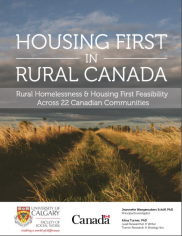This question came from Ryan W. via our latest website survey: How can we develop policy solutions which bridge the urban/rural differences in homelessness in some way?
Homelessness is often considered a big city problem, but it exists in rural and northern communities too. As we’re always writing here at Homeless Hub, homelessness is a broad spectrum that can look many different ways: sleeping on streets or couches; as well as in transitional housing and shelters. In rural and northern communities, there tends to be much more hidden homelessness: doubling up, sleeping in vehicles/campers, couch-surfing, and so on.
Too often, the invisibility of rural homelessness contributes to the lack of attention to it. As Alina Turner pointed out in a post she wrote last year:
Though hidden, rural homelessness is very diverse: it reaches across the lifespan to children, youth, and seniors; it's experienced by women and men alike, newcomers and Aboriginal people; it's experienced by low income individuals with and without addiction or mental health issues, or facing domestic violence. Of course, the total numbers of homeless are much lower in small communities - which make the issue less visible as well. This impacts public recognition and action to address the issue. When you don't see homelessness, it's easier to deny it exists and it's easier to push it to the bottom of the community agenda.
In cities, we see people experiencing homelessness so frequently that it is almost impossible to ignore. There are other key differences summarized by Turner, including: strained service and housing infrastructure, keenly felt economic shifts, “the migration solution,” and a lack of disaster preparedness. These factors also affect northern communities, along with high construction costs, more rapidly deteriorating housing, and very little supportive housing (see Nick Falvo’s blog post for more information).
Though there are differences between urban and rural homelessness, there are many solutions we can propose that address both types of homelessness.
Potential policy solutions
The recommendations from the State of Homelessness in Canada 2014 report are broad and address a number of the systemic causes of homelessness, thus making them beneficial in both rural and urban contexts:
- A federal, provincial and territorial framework for affordable housing
- Investments to help those who episodically and chronically homeless
- Direct investments in affordable housing
- Benefits for people experiencing housing affordability issues
- A new affordable housing tax credit
- Investments in Aboriginal housing, on and off reserve
I would also add advocacy and activism around implementing a guaranteed liveable income for all, which Simon Lewchuck wrote about in 2013, arguing that “…a guaranteed income would allow for fuller participation in family and society. It’s a bold idea that could help us fulfill our public justice responsibility towards our fellow citizen, recognizing one another’s inherent worth and right to a life of dignity regardless of one’s position or role in society.”
These are all long-term policies that are very important to help end homelessness in the future, but don’t speak to the severe and urgent need for emergency services in rural areas right now.
Housing First has been embraced by Canada’s Homelessness Partnering Strategy and has seen success in several cities across the country. Though there are challenges to making Housing First happen in smaller communities, it isn’t an impossible task. Housing First in Rural Canada explored the feasibility of the program in 22 rural communities, finding that as long as Housing First is adapted to rural contexts, it can be successful. Some recommendations include
- Creating materials that speak to the realities of smaller communities (ie. focus less on ACT and other urban models)
- Leveraging multiple funding streams, including support from private landlords and homeowners
- Advocating for a systems-level approach to homelessness
The dependency on private market housing and a lack of shelters/transitional housing is a particularly difficult barrier, but one that communities are finding creative solutions to overcome. As Dr. Stephen Gaetz said during a webinar on rural homelessness:
There may be other options that one has to explore and that’s going to require the ingenuity and innovation on the local level. It may mean going the route of host homes for a while until people can find their own housing. The host home model is established in the UK and in the United States in certain communities. And in Canada there are at least two places where it’s being done; I believe in Victoria and also the Halton region in Ontario. So that means getting people in the community who have extra rooms, might be parents whose children have moved out, to make available a room for somebody to move into.
In Drayton Valley, Alberta, residents are also coming together to provide emergency supports for people in need. According to Global News: “Since the implementation of the strategy on homelessness, more than 60 people have been helped through several efforts including a community assistance fund and a volunteer-run mat program housed at a local church. Work continues on more permanent solutions.”
As folks in the article point out, securing funding for these kinds of programs can not only end homelessness, but also keep people in their communities – instead of giving them bus tickets to cities, where they may have no prospects or social support. Rural and northern communities need a commitment from all levels of government to offer the housing and support needed by their residents.
For more information, check out:


